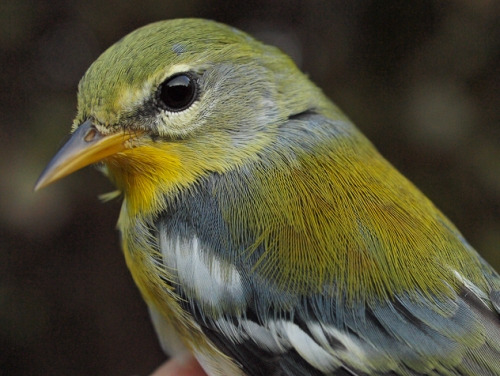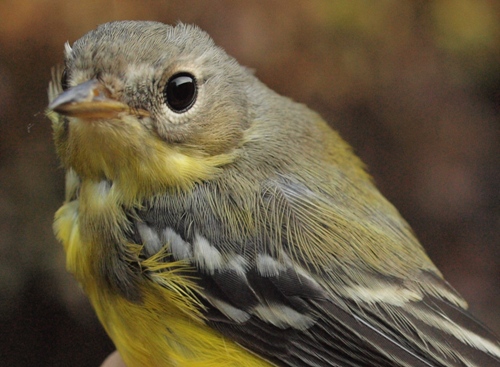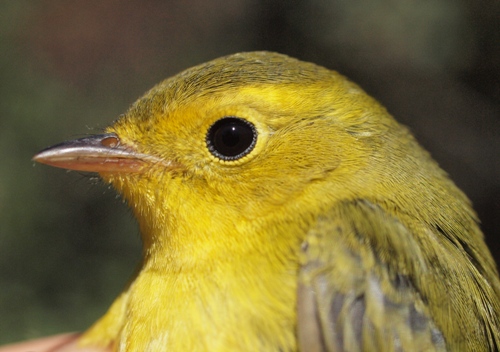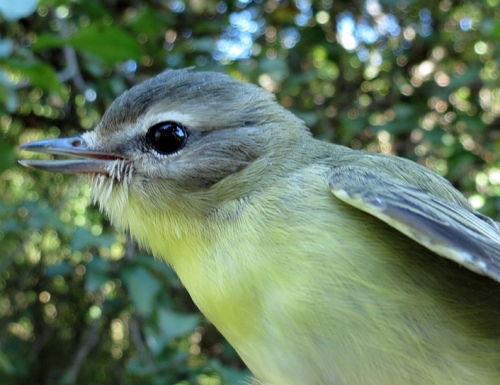|
Week 6: September 5 - 11, 2013 |
Welcome
to the McGill Bird Observatory weekly report.
Click here for a complete listing of our archives.
Comments or
questions are welcome at "mbo AT migrationresearch.org".
|
PICTURE
OF THE WEEK: |
|

This was just our second Northern Parula of fall 2013.
(Photo by Simon Duval)
-
|
|
|
THIS WEEK |
THIS FALL |
2013 TOTAL |
SITE TOTAL |
|
# birds (and species) banded |
234 (33) |
1503 (62) |
2798 (86) |
44310 (113) |
|
# birds (and species) repeat |
54 (15) |
373 (35) |
703 (50) |
8684 (70) |
|
# birds (and species) return |
2 (2) |
28 (15) |
183 (34) |
1392 (38) |
|
# species observed |
82 |
122 |
161 |
208 |
|
# net hours |
480.0 |
3155.5 |
6512.3 |
75802.0 |
|
# birds banded / 100 net hours |
48.8 |
47.6 |
43.0 |
58.4 |
|
|
Note: table does not include nocturnal banding (owls) |
|
Banders-in-charge: Simon Duval, Gay Gruner
Assistants: Christine Barrie, Sue Bishop, Marc Boisvert, Cindy Bouchard, Carl Bromwich, Luke Currin, Jean Demers, Jo-Annie Gagnon, Kirsten Gavin, Nathalie Gendron, Alison Hackney, Frédéric Hareau, Lisa Keelty, Barbara MacDuff, Francine Marcoux, Betsy McFarlane, Ana Morales, Catherine Russell, Ahmad Shah, Clémence Soulard, Patricia Stotland, Elise Titman, Rodger Titman, Yifu Wang
IMPORTANT: MBO has been selected as one of five finalists in the Jamieson Vitamins "Call for the Wild" contest for 2013. To support MBO, all you need to do is vote daily between August 19 and September 15 by visiting the contest Facebook page (no login required). Four other organizations are competing for their share of $100,000, and the amount allocated to MBO will be entirely dependent on the number of votes received. Please help us succeed with this important fundraiser by voting for MBO every day!
Notes: Historically, week 6 of fall has been one of the most variable periods at MBO, with as few as 109 birds banded in 2009 (despite losing only 6 of 560 net hours all week) to as many as 416 the next year (in just 456.5 net hours). Over the past three years though, more average numbers have become the norm, with 257 in 2011, 263 last year, and 234 this year. However, diversity was surprisingly low this week - the 33 species banded ties the low recorded in 2009. As discussed further below the top ten tables, this week's volume was largely thanks to strong movements by a couple of warbler species. The count of 82 species observed was also a bit below average this week, with between 84 and 86 in six of eight previous fall seasons. However, thanks to a productive August and the arrival of a few more "new" species for the season, the total of 122 for fall remains the highest ever at this point in the season.

Magnolia Warblers accounted for nearly one-third of birds banded at MBO this week.
(Photo by Simon Duval)
|
The highlights among this week's five "new" species for the fall were two owls. An Eastern Screech-Owl was heard on the first day of the week, and then on September 7, Marc Boisvert spotted a juvenile Northern Saw-whet Owl on the far side of Stoneycroft Pond while conducting census. Although we have a fair number of saw-whets moving through MBO from late September to early November, we have never recorded them outside of migration, and the fact this one was in juvenile plumage suggests it is the product of a nearby nest, perhaps in the Morgan Arboretum. Another exciting find on the same morning was a Yellow-billed Cuckoo along the edge of the farm field - a species we observe less than annually. All three of these species were new for 2013. Other "regular" fall migrants that began to arrive this week were Gray-cheeked Thrush and Lincoln's Sparrow - which happened to also be the only two species this week banded for the first time this fall.
This week’s top 10 [last week's rank in brackets]
# individuals banded |
mean # individuals observed daily |
1. Magnolia Warbler (70) [2] |
1. American Crow (49) [3] |
2. Tennessee Warbler (36) [1] |
2. American Goldfinch (35) [1] |
3. American Redstart (18) [3] |
3. Cedar Waxwing (20) [2] |
4. American Goldfinch (13) [7] |
4. Black-capped Chickadee (18) [4] |
5. Wilson's Warbler (11) [-] |
5. Red-winged Blackbird (15) [-] |
6. Common Yellowthroat (10) [4] |
6. Magnolia Warbler (15) [8] |
7. Indigo Bunting (8) [9] |
7. Blue Jay (14) [7] |
8. Blackpoll Warbler (7) [-] |
8. European Starling (12) [-] |
9. Red-eyed Vireo (6) [5] |
9. Canada Goose (11) [-] |
10. Cedar Waxwing (5) [-]
10. Ovenbird (5) [10]
10. Rose-breasted Grosbeak (5) [-]
|
10. Tennessee Warbler (11) [4]
|
|
After two weeks in which the top three species banded were unchanged, there was a slight adjustment this week with Magnolia and Tennessee Warbler swapping the top two positions. This is not surprising, as mid-September is typically the peak of Magnolia Warbler migration at MBO, so numbers are building right on schedule, whereas Tennessee Warblers are expected to gradually taper off now. However, the season total for Tennessee Warbler has now reached 208, which is more than any other species to date this fall, and matches the fall record for the species set in 2011 (which will no doubt be broken next week). American Redstart remained in third place, and with a total so far this fall of 122, appears headed toward the range of 139 to 150 banded in fall each of the past three years. Goldfinches and Wilson's Warblers increased in numbers this week, rounding out the top five. Common Yellowthroat and Indigo Bunting continue to steadily add to their season totals, which so far appear to be somewhat above average, though not necessarily on pace for new records. Blackpoll Warbler typically peaks at MBO in early September, and showed up this week right on cue. Red-eyed Vireos dropped a bit from last week. Ovenbird anchored the bottom of the top ten for a second week in a row, joined by a small resurgence of Cedar Waxwings and a relatively late push of Rose-breasted Grosbeaks. Magnolia Warbler has now been the top species banded in week 6 in seven of nine years; interestingly though, in the other two years it was White-throated Sparrow - and we banded just one of them this week! Are they scarce this year, or just late?
The top four species observed this week remained the same as last week although there was a bit of juggling among the top three, with American Crow vaulting up to top spot from third place last week, thanks to some larger flocks beginning to form and pass over MBO. This is the fifth time in nine years that crows have been the most numerous species in week 6. The fall blackbird flocks are also starting to build, as reflected in Red-winged Blackbird cracking the top five. The increase in Magnolia Warblers was reflected in observations too, as was the drop in Tennessee Warblers this week. Blue Jay held on to seventh place yet again, probably as usual a mix of a couple of local birds and some modests number of migrants moving through. European Starling and Canada Goose were the other new additions to the top ten this week, while American Robin, Common Yellowthroat, and Song Sparrow dropped off.
|

Wilson's Warblers increased this week; compare this green-capped hatch-year female with the black-capped after-hatch-year male in last week's report.
(Photo by Simon Duval)

Philadelphia Vireo is always an uncommon migrant at MBO - this was just the second individual banded this fall.
(Photo by Gay Gruner)
|




